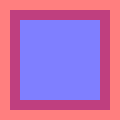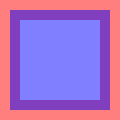canvas-fill-and-stroke
[CanvasRenderingContext2D] fill-and-stroke function
Status: explainer
Ticket: Open
CanvasRenderingContext2D offer the possibility to fill or stroke a path.
Problem is, these are two separate action taken by the renderer.
Meaning that doing both can lead to unexpected conflict between the two functions.
For example, setting shadow option and calling fill and stroke will draw a shadow for the fill and the stroke.
There’s currently no easy way to draw one shadow for both fill and stroke.
Also, when using a lower than 1 globalAlpha value, fill and stroke will overlap.
Moreover, the order in which fill and stroke are called can drastically change the resulting output.
Putting users are risk of generating unexpected result.
Proposal
interface CanvasRenderingContext2D {
void fillAndStroke();
};
fillAndStroke will do both fill and stroke action according to the current CanvasRenderingContext2D state.
However, both will be done in a single call and will share the same side effects.
Open issues and questions
- Change the name - #1
Example usage
// Javascript example
const canvas = document.createElement("canvas");
const context = canvas.getContext("2d");
context.globalAlpha = 0.5;
context.beginPath();
context.rect(50, 50, 100, 100);
context.fillAndStroke();
Demonstration
| Test | Result | Result (stroke first) | Expected |
| — | — | — | — |
| Opacity | |
| |
| |
| Shadow |
|
| Shadow | |
| |
| |
|
Click on images to see the live version
Alternatives considered
Alternative 1
As per the proposed polyfill file, one could draw in an OffscreenCanvas and render the whole result in one call with drawImage.
However, this has a few drawbacks:
- The added (copy) steps greatly reduce the performance
- With larger Canvas,
drawImagehas a big impact on memory and performance because of the bitmap reading. - This implementation can’t read the current path and has to have a
pathgiven as parameter. - This is a hack and surely prone to bugs.
For a peek at the performance drop, check out the Benchmark page.
References
none